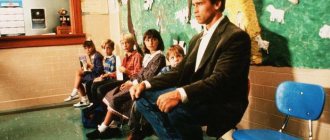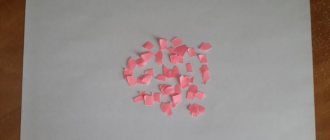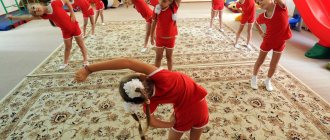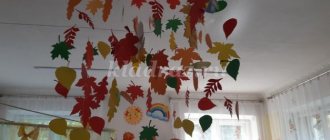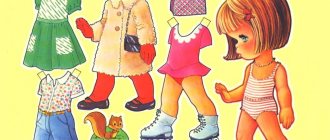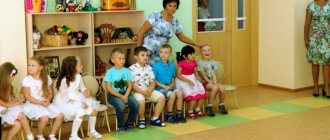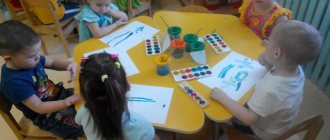Games for social and communicative development
Games aimed at the social and communicative development of a child have the following goals:
- perception of norms of social behavior;
- development of communication skills, cooperation skills with other children and adults;
- development of empathy;
- developing a sense of respect and belonging to one’s family and peer group;
- formation of a positive attitude towards work and creative activity;
- developing safe behavior skills.
Game "Who needs what"
Purpose: to introduce the main characteristics of such professions as doctor, hairdresser, baker; develop a positive attitude towards work.
For the game you need to prepare items necessary to perform professional activities (syringe, scissors, comb, bowl, etc.), as well as details of the corresponding costumes. Children are assigned to roles.
First, you need to have a conversation with the children about the professions of a doctor, hairdresser, baker (you can choose others). It is necessary to find out what the kids know about their professional activities. You can ask which of the children have parents with such professions.
During the game, each child first receives costume parts. He must understand what profession he needs to represent. If children find it difficult to answer, the leader helps them.
Next, a game is played with objects that are stacked on the table. Children need to choose a subject that is necessary for their professional activities. After this, you can invite them to show how this item should be used.
Game "Yes or No"
Goal: to cultivate a caring attitude towards health; learn to manage your behavior, understand what actions are correct.
Children stand in a circle. The teacher should name various situations, and the kids should, if the correct behavior is announced, clap their hands, if incorrect, stomp their feet.
Game "Who to be friends with"
Goal: to teach children to understand people’s facial expressions; develop empathy, cultivate friendliness.
Place pictures of children with different facial expressions on the board. The children are invited to look at the pictures and choose a friend. The facilitator should ask them to explain their choice.
Games for the cognitive development of children of the second younger group
The purpose of games aimed at the cognitive development of a child is:
- development of interests, cognitive activity and motivation, curiosity;
- formation of cognitive skills;
- the formation of the child’s ideas about himself and other people, about the objects of the surrounding world, their properties and relationships between them;
- familiarization with the concepts of “Fatherland”, “homeland”, the basic socio-cultural values and traditions of one’s people.
Game “Into the forest to pick mushrooms”
Goal: developing ideas about quantitative relationships between objects “one - many”.
To play the game, you need to prepare an image of a large clearing on which several mushroom figures are located. Children need to be given baskets.
- Children, we came to a mushroom clearing in the forest. Look how many mushrooms there are here? (A lot of).
- And now each of you will pick one mushroom. Tell me one by one how many mushrooms are in your basket. How much do you have, Vitya? (I have one mushroom).
The teacher should ask each child.
- Let's put all the mushrooms in my basket. How many mushrooms did I get? (A lot of). And you? (No one).
Game "Wrap a gift"
Goal: to form the concept of “big”, “small”, “thick”, “thin”; learn to correlate objects by size.
The presenter invites the children to go to Mashenka’s birthday party. To do this they need to buy a gift. Everyone chooses a doll (the pictures show dolls of different sizes and thicknesses).
Now you need to pack the gift, and for this the children need to “buy” a package that will correspond to the size of the doll. At the same time, each child must explain his choice of packaging: “I bought this package because my doll...”.
After this game, you can discuss how to properly give and accept gifts.
Game "What grows where"
Goal: learn to group objects into vegetables and fruits; develop speed of reaction, discipline, endurance.
For the game, you need to prepare pictures depicting a vegetable garden and object pictures (or dummies) of vegetables and fruits.
Children are divided into two teams: gardeners and vegetable growers. At the signal, each team must collect their items. The team that completes the task faster wins.
Games that promote physical development
Games that promote physical development are aimed at:
- developing motor skills in children;
- development of coordination, balance, hand motor skills and flexibility;
- proper formation of the musculoskeletal system;
- training in the correct execution of basic sports movements;
- formation of healthy lifestyle skills.
Game "Swing"
Goal: learn to perform various rhythmic movements; development of coordination and balance.
The presenter invites the children to repeat the lines of the poem after him and perform the appropriate movements.
All summer swing
They swayed and sang,
And we're on a swing
(Children begin to swing their arms back and forth, slightly springing their legs at the knees when squatting).
Autumn days have arrived.
The swings were left alone.
(Reduce the intensity of movements and gradually stop).
Lying on a swing
Two yellow leaves.
(They slowly begin to move their hands again.)
Game "Musical chair"
Goal: to develop motor skills, learn to run in circles, develop attentiveness, learn to act on a signal.
To start the game, you need to place several chairs in a circle in the center of the room (one less than the number of participants). Children should stand in a circle around the chairs. The teacher turns on the music.
While the music is playing, the children run in a circle. As soon as the music stops, everyone should sit on a separate chair. There is not enough chair for one child. He leaves the game and the chair is removed. Then the game repeats. This continues until there is only one child left.
Game "On a walk"
Goal: to learn physical exercises in motion, prevention of flat feet.
Before the game starts, children line up in a column. The teacher tells them that they are going for a walk and asks them to listen to his story and repeat all the movements.
— We are walking along the path (the children follow each other).
- We need to cross the puddle (they walk on their heels).
— We approached the apple tree and wanted to try its apples. Reach for them (walk on your toes).
- We need to jump over the stream (they jump).
- You met a bear cub, show how he walks (they walk on the outside of the foot).
The presenter can offer different movement options. For one game session, children are given no more than five different tasks.
